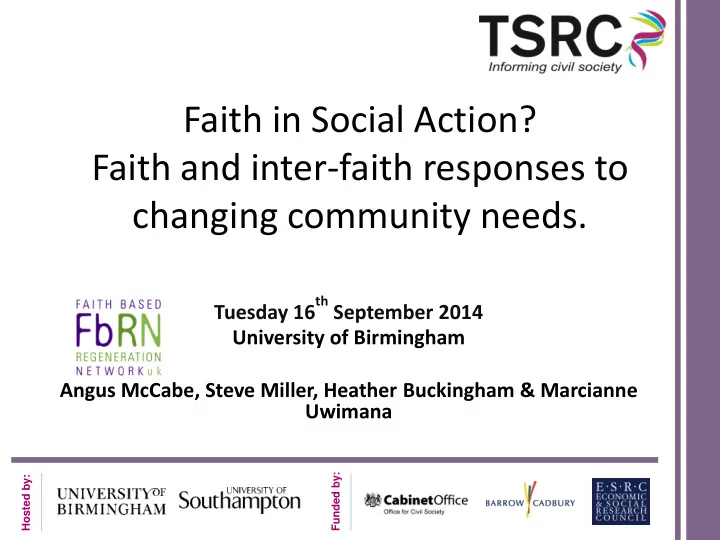

Faith in Social Action? Faith and inter-faith responses to changing community needs. th September 2014 Tuesday 16 University of Birmingham Angus McCabe, Steve Miller, Heather Buckingham & Marcianne Uwimana Funded by: Hosted by:
RESEARCH AIMS • To explore o The role and resources of faith and inter-faith groups in addressing changing community need o The strengths and weaknesses of faith based social action: opportunities and challenges o What works in inter-faith initiatives o Looking to the future
RESEARCH METHODS • Literature review: academic and practice based • Individual interviews with leaders of faith (and inter-faith) based organisations and groups: multi-cultural/faith case study area, city/region and national. • To date – interviews with 30 key informants from four faiths and inter-faith forums • Focus group and feedback workshops
RESEARCH CONTEXT AND CHALLENGES • A strong view from participants that debate on faith had been ‘hijacked’ by: o Prevention of Violent Extremism agenda o Faith school debate and ‘Trojan Horse’ o Opinion rather than evidence • Issues of interview access: time pressures, cuts to inter-faith structures – from paid staff to volunteers
FAITH BASED SERVICES • Both broad range of ‘mainstream’ services; play and youth provision, older people/day care, money advice etc • And strong emphasis on work with ‘the most vulnerable’ or ‘those rejected by wider society ’: homeless, substance use, refugees and asylum seekers, guns and gangs etc • Largely volunteer based responses rather than contractual/externally funded
HOW FAITH GROUPS IDENTIFY NEEDS • Research – but relatively limited • Presence – Being ‘close to the ground’: ‘faith buildings are often the only places left in poor communities when other services leave’ • Conversations • Outreach • The lived experiences of members • ‘The numbers turning up at the door’ (foodbanks)
CHANGING AND EMERGING NEEDS • Growth of o Food poverty o Fuel poverty o Debt o In work poverty o Impact of above on family as a shared focus • Impact of benefit sanctions and ‘no recourse to public funds’ • Growing divide in ‘the recovery’ between the ‘haves’ and ‘have nots’
RESOURCES AND STRENGTHS • Across faith groups o Independent sources of funding o Not working to a pre-set/contractual agenda o Volunteer base o Buildings and presence o Skills of staff and volunteers o Histories of engagement o Diversity o BUT…..
RESOURCES AND SERVICES • Across faith groups – 4 approaches to utilise resources and develop services. 1 Buildings for worship only 2 Broader use of resources/services – for members only 3 Opening up resources/services to wider community 4 Partnership working; secular and other faiths
WEAKNESSES AND CHALLENGES • Volunteers as a finite resource • Financial resources declining – established churches: aging volunteer and finance base • Skills gaps: ‘faith leaders are trained theologians but lack other skills: project management, fundraising, partnership working etc etc’ • ‘A sticking plaster not a solution’: the scale of need • Legal compliances • Lack of co-ordination – competition for resources and fragmentation and information ‘gaps’ • ‘Paid staff let the congregation off ’
SIMILARITIES AND DIFFERENCES • Demographics of different faith groups: aging versus young member profiles • Individual faith leaders as key players in shaping/facilitating responses • ‘Faith based’ versus ‘faith driven’ responses • Charity versus enterprise models of working • Welfare (mitigating poverty) versus social change
THE DIMENSION OF FAITH • Can be difficult to disaggregate faith, belief, religion and culture • Notions of social, spiritual, and religious capital (e.g. Baker and Smith, 2010) • But, these categorisations may not correspond with the worldviews and practices of the communities concerned • Faith, belief and received traditions as key motivators
THE DIMENSION OF FAITH • Complex faith: ‘liberal’ versus ‘conservative’ theologies too simplistic • Conflicted faith ‘ service..but it is shameful we have foodbanks. We are administering the new Poor Law in the 21 st century…without the resources’ • Institutional landscape is also contested, complex and inter-woven
Conceptualising Faith Communities’ Presence Social Engagement… Resources: Spiritual Financial People Time Skills and Character Buildings E Change Encounter Relationships Local knowledge Personal experience Reputation Wisdom/teachings Values Hope Response
INTER-FAITH WORKING • History of formalised structures: often imposed and with ‘external agendas’ • From Christian ‘inter - denominational’ work to inter -faith • ‘Faiths are not monolithic. Differences between dominations can be as important as those between faiths’ • Loss of energy: concentration on governance and talk rather than action • Withdrawal of inter-faith funding • ‘You disinvest in inter faith work at your peril’
‘NEW’ APPROACHES TO INTER FAITH WORK • Informality but ‘It’s hard work’ • Building relationships – not structures – from the very local level to faith leaders • Emphasis on issues and action not dialogue per se • Responding to ‘aggressive secularism’ • Common humanity not theological difference: ‘different faiths have different beliefs – so what’?
LOOKING TO THE FUTURE 1 • Challenge of Islamophobia • Capacity to respond to increasing levels of need • Changing demographics: young people ‘re - negotiating their relationship with faith’ • The media; right wing attitude to welfare • Closing down of space for dialogue/political dialogue; challenging policy = extremism and challenging the state
LOOKING TO THE FUTURE 2 • How long do we have to keep pulling people out off the river before we go up-stream and see who is throwing them in ? • (Inter)-faith relations with a secular state; lacking a shared language • Faith and its relevance in everyday lives/communities; faith alone v ‘good works’ • Faith buildings: assets or liabilities? • Other
NEXT STEPS • For feedback after this event contact a.j.mccabe@bham.ac.uk • Report writing (October 2014) – out for comments from participants • Launch (December 2014) • How to use the report……….
Recommend
More recommend